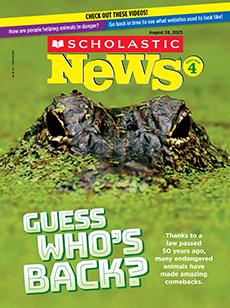In Washington, D.C., a four-page document is under 24-hour protection. It is locked inside a case made of thick metal and glass. A team of experts spent five years designing and building the case, which cost more than $5 million. Why all the fuss? That document is the original U.S. Constitution, which set up our national government.
Protecting Our Past
Michael Ventura/Alamy Stock Photo
Each year, more than 1 million visitors view the U.S. Constitution at the National Archives Museum.
For the People
The 13 American Colonies won their independence from Great Britain in the Revolutionary War (1775-1783). America’s Founders realized that their new nation needed a strong government.
Representatives from the states spent nearly four months writing the Constitution. The final text was handwritten on parchment, which is made from animal skin. On September 17, 1787, Benjamin Franklin, George Washington, and 37 others signed it. (September 17 is known as Constitution Day.)
National Archives and Records Administration
The Constitution begins with three famous words: We the People. America’s Founders used these words to show that the new nation would get its power from its citizens, not from its government.
Safe and Sound
Today, the signatures are still visible, but the document itself is very fragile. Exposure to the air or moisture and changes in temperature can damage the parchment. Too much light can cause the ink to fade.
The high-tech case protects the Constitution from these dangers. Today, the famous document is on display at the National Archives Museum.
The Constitution also needs to be protected from threats such as theft or natural disasters. For many years, the case was lowered into a vault under the floor each night. Government officials won’t say whether this is still done today. Their security plans are top secret. But they do have safety measures in place to make sure that the Constitution can be seen by people for years to come.
“Being able to stand in front of the actual document is pretty cool,” says Alice Kamps, who works at the National Archives Museum.
